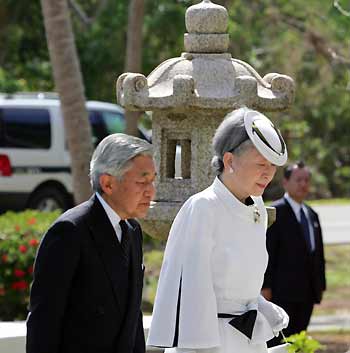|
Japan emperor makes surprise stop at Korea memorial
(Agencies)
Updated: 2005-06-28 10:35
Japanese Emperor Akihito, on a pilgrimage to the U.S. territory of Saipan where a decisive World War II battle was fought, abruptly changed his official schedule on Tuesday to visit a memorial to Koreans who died in the war.
Akihito's journey, his first trip outside Japan to pay respects to war dead, coincides with a deterioration in Japan's ties with China and South Korea, still tormented by the wartime past 60 years later.
Korean residents of Saipan had asked the emperor to visit the memorial to their fallen compatriots, but until Tuesday they had received no reply.

Japan's Emperor Akihito (L), accompanied by Empress Michiko, arrives at the Monument of the War Dead in the Mid-Pacific, to pay their respects to the Japanese soldiers who died in the bloody World War Two Battle of Saipan, in Saipan June 28, 2005. [Reuters] |
About 1,000 Korean laborers were brought to the island against their will during the 1930s, joining thousands of Japanese workers relocated there after World War One.
Most Koreans left on the island when World War II ended were repatriated to the Korean peninsula, and the 2,500 Koreans now living on Saipan mostly came during the past 30 years.
A Japanese Imperial Household Agency official said the news media were not told in advance of the emperor's decision to visit the Korean cenotaph because of a possible security risk.
"It was a choice between taking a risk and not notifying (media). We decided not take a risk," he told reporters.
Many South Koreans still resent Japan's often brutal 1910-1945 colonization of the Korean peninsula, and a meeting of the two countries' leaders last week failed to thaw the recent diplomatic chill.
Despite public apologies by Japan's leaders and words of regret from Akihito himself, many in those countries feel Japan has not atoned enough for its wartime atrocities in Asia.
They are especially outraged over Prime Minister Junichiro Koizumi's repeated visits to Tokyo's Yasukuni shrine, seen by critics as a symbol of past Japanese militarism.
Japanese officials have stressed that Akihito -- son of the late Emperor Hirohito, in whose name Japanese fought and died -- is paying his respects to war dead of all nationalities.
In another unscheduled stop on Tuesday, the emperor visited a memorial for war dead from Japan's southern island of Okinawa who died on Saipan.
Before visiting the two smaller private memorials, Akihito laid flowers at the Monument of War Dead in the Mid-Pacific, built by the Japanese government in 1974 to honor all who died in the conflict.
He also offered silent prayers at two rocky heights, known as Banzai Cliff and Suicide Cliff, where many Japanese soldiers and civilians leapt to their deaths rather than surrender in shame.
The emperor was scheduled later to lay flowers at a memorial for natives of Saipan who died in the battle and at an American Memorial, where 26 granite plates are inscribed with the names of Marines, Army and Navy personnel who were killed.
Saipan, controlled by Japan after World War One and considered vital to Japan's homeland defense, saw fierce fighting from June 15 to July 9, 1944.
U.S. forces wanted the island as a base from which its new B-29 bombers could strike Japan's mainland to the north.
More than 5,000 Americans died in the battles for Saipan and nearby Tinian and the naval Battle of the Philippine Sea, along with some 900 native islanders, including infants and elderly.
Some 43,000 Japanese soldiers and 12,000 Japanese civilians died in the intense fighting, according to Japanese figures.
'NOT AFRAID OF DEATH'
Japanese before the war had been taught a nationalist ideology that made it a virtue to die for the sake of an emperor worshipped as a living god. Propaganda about certain rape and torture if taken prisoner by Americans was also common.
"They had to fight for Japan, for their families. That is how they were educated and they were not afraid of death," said Tai Watanabe, 78, whose brother died in fighting on Guam and who himself had been trained to die as a "kamikaze" pilot.
Akihito attends annual ceremonies in Japan on the Aug. 15 anniversary of the war's end, and 10 years ago he visited memorials in Tokyo, Hiroshima, Nagasaki and Okinawa.
But elderly Japanese veterans and relatives of war dead -- many firm supporters of Koizumi's ruling party -- are pleased that the royal couple is making the pilgrimage abroad.
Katsuya Ogawa, 62, whose father died on Saipan, took part in an audience with the emperor on Monday. "Sixty years have passed since the end of the war and while there are people opposed to the emperor's visit...we are warmly grateful," Ogawa said.
The huge loss of life on Saipan was repeated on Iwo Jima and Okinawa the next year and helped persuade the United States to drop atomic bombs on Hiroshima and Nagasaki in August 1945, prompting Japan's unconditional surrender.
The planes carrying both bombs took off from nearby Tinian.
|